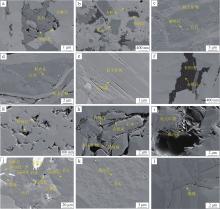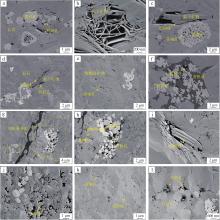

石油与天然气地质 ›› 2022, Vol. 43 ›› Issue (6): 1497-1504.doi: 10.11743/ogg20220618
收稿日期:2022-02-13
修回日期:2022-09-12
出版日期:2022-11-21
发布日期:2022-11-21
通讯作者:
卢双舫
E-mail:liwh@upc.edu.cn;lushuangfang@upc.edu.cn
第一作者简介:李文浩(1985—), 男, 副教授、硕士生导师,非常规油气地质、古海洋学与有机地球化学。E-mail: 基金项目:
Wenhao Li( ), Shuangfang Lu(
), Shuangfang Lu( ), Min Wang, Nengwu Zhou, Zehu Cheng
), Min Wang, Nengwu Zhou, Zehu Cheng
Received:2022-02-13
Revised:2022-09-12
Online:2022-11-21
Published:2022-11-21
Contact:
Shuangfang Lu
E-mail:liwh@upc.edu.cn;lushuangfang@upc.edu.cn
摘要:
高分辨率扫描电镜技术是研究致密储层非均质性最直观的方法,但存在视域代表性的问题。以南襄盆地泌阳凹陷古近系核桃园组三段致密储层为例,基于扫描电镜大视域拼接技术,定量揭示了不同类型致密储层的微观非均质性。结果表明,研究区致密砂岩储集空间类型以粒间孔和粒内孔为主,同时发育少量微裂缝;泥页岩储集空间类型同样以粒间孔和粒内孔为主,有机孔和微裂缝相对较少。通过场发射扫描电镜大视域拼接技术与统计学方法结合,探讨了泥岩、页岩、泥质粉砂岩、砂岩等致密储层的矿物微观非均质性和孔隙微观非均质性。其中边长为160,300,300和1 000 μm的正方形视域面积可以分别作为上述4种岩性致密储层矿物微观非均质性代表视域面积;边长为200,300,300和800 μm的正方形视域面积可以分别作为上述4种岩性的孔隙微观非均质性代表视域面积。由此可见,不同岩石类型的致密储层,其微观非均质性存在明显差异,其中砂岩微观非均质性 > 泥质粉砂岩、页岩微观非均质性>泥岩微观非均质性。综合矿物微观非均质性和孔隙微观非均质性,可将边长为200,300,300和1 000 μm的正方形视域面积分别作为研究区泥岩、页岩、泥质粉砂岩和砂岩致密储层微观非均质性的代表视域面积。
中图分类号:

图2
泌阳凹陷核三段致密砂岩储层储集空间类型SEM图像a.长石、石英、方解石等矿物粒间孔, 泌212井, 埋深3 195.20 ~ 3 195.30 m; b.方解石和长石晶间孔和粒内溶孔发育, 可见少量有机孔, 泌212井, 埋深3 195.20 ~ 3 195.30 m; c.长石和粘土矿物晶间孔, 泌212井, 埋深3 195.20 ~ 3 195.30 m; d.少量晶间孔和粒内孔, 泌212井, 埋深3 195.20 ~ 3 195.30 m; e.粘土矿物层间缝发育, 泌212井, 埋深3 195.20 ~ 3 195.30 m; f. 有机孔, 泌212井, 埋深3 195.20 ~ 3 195.30 m; g, h.粒间孔和晶间孔, 安84井, 埋深3 031.72 ~ 3 031.87 m; i.发育少量粒内孔, 安84井, 埋深3 031.72 ~ 3 031.87 m; j, k.晶间孔较发育, 同时含少量粒内溶孔, 安84井, 埋深3 031.72 ~ 3 031.87 m; l.微裂缝, 安84井, 埋深3 031.72 ~ 3 031.87 m"


图3
泌阳凹陷核三段泥页岩储层储集空间类型SEM图像a.少量粒间孔和晶间孔, 泌246井, 埋深3 446.40 ~ 3 446.47 m; b, c.粘土矿物晶间孔、长石晶间孔和溶蚀孔, 泌246井, 埋深3 446.40 ~ 3 446.47m; d.少量层间缝及有机孔, 泌246井, 埋深3 446.40 ~ 3 446.47 m; e.晶间孔和溶蚀孔, 泌246井, 埋深3 446.40 ~ 3 446.47 m; f.有机质及部分有机孔, 泌246井, 埋深3 446.40 ~ 3 446.47 m; g.有机质及部分有机孔, 泌页1井, 埋深2 443.30 ~ 2 430.35 m; h.晶间孔和溶蚀孔, 泌页1井, 埋深2 443.30 ~ 2 430.35 m; i.层间缝, 泌页1井, 埋深2 443.30 ~ 2 430.35 m; j—l.粘土矿物晶间孔、长石晶间孔和溶蚀孔,泌页1井, 埋深2 443.30 ~ 2 430.35 m"

| 1 | 戴金星, 倪云燕, 吴小奇. 中国致密砂岩气及在勘探开发上的重要意义[J]. 石油勘探与开发, 2012, 39(3): 257-264. |
| Dai Jinxing, Ni Yunyan, Wu Xiaoqi. Tight gas in China and its significance in exploration and exploitation[J]. Petroleum Exploration and Development, 2012, 39(3): 277-284. | |
| 2 | 冯子辉, 印长海, 陆加敏, 等. 致密砂砾岩气形成主控因素与富集规律——以松辽盆地徐家围子断陷下白垩统营城组为例[J]. 石油勘探与开发, 2013, 40(6): 650-656. |
| Feng Zihui, Yin Changhai, Lu Jiamin, et al. Formation and accumulation of tight sandy conglomerate gas: A case from the Lower Cretaceous Yingcheng Formation of Xujiaweizi Fault Depression, Songliao Basin[J]. Petroleum Exploration and Development, 2013, 40(6): 696-703. | |
| 3 | 朱如凯, 吴松涛, 苏玲, 等. 中国致密储层孔隙结构表征需注意的问题及未来发展方向[J]. 石油学报, 2016, 37(11): 1323-1336. |
| Zhu Rukai, Wu Songtao, Su Ling, et al. Problems and future works of porous texture characterization of tight reservoirs in China[J]. Acta Petrolei Sinica, 2016, 37(11): 1323-1336. | |
| 4 | Schmitt M, Fernandes C P, da Cunha Neto J A B, et al. Characterization of pore systems in seal rocks using nitrogen gas adsorption combined with mercury injection capillary pressure techniques[J]. Marine and Petroleum Geology, 2013, 39: 138-149. |
| 5 | Anovitz L M, Cole D R. Characterization and analysis of porosity and pore structures[J]. Reviews in Mineralogy & Geochemistry, 2015, 80: 61-164. |
| 6 | Li W H, Lu S F, Xue H T, et al. Microscopic pore structure in shale reservoir in the argillaceous dolomite from the Jianghan Basin[J]. Fuel, 2016, 181: 1041-1049. |
| 7 | Xiao D S, Lu Z Y, Jiang S, et al. Comparison and integration of experimental methods to characterize the full-range pore features of tight gas sandstone: A case study in Songliao Basin of China[J]. Journal of Natural Gas Science and Engineering, 2016, 34: 1412-1421. |
| 8 | Zhang L C, Lu S F, Xiao D S, et al. Characterization of full pore size distribution and its significance to macroscopic physical parameters in tight glutenites[J]. Journal of Natural Gas Science and Engineering, 2017, 38: 434-449. |
| 9 | Zhang L C, Xiao D S, Lu S F, et al. Pore development of the Lower Longmaxi shale in the southeastern Sichuan Basin and its adjacent areas: Insights from lithofacies identification and organic matter[J]. Marine and Petroleum Geology, 2020, 122: 104662. |
| 10 | Lai J, Wang G W, Wang Z Y, et al. A review on pore structure characterization in tight sandstones[J]. Earth Science Review, 2018, 177: 436-457. |
| 11 | Gao Z Y, Yang X B, Hu C H, et al. Characterizing the pore structure of low permeability Eocene Liushagang Formation reservoir rocks from Beibuwan Basin in northern South China Sea[J]. Marine and Petroleum Geology, 2019, 99: 107-121. |
| 12 | Tian W C, Lu S F, Huang W B, et al. Study on the full-range pore size distribution and the movable oil distribution in glutenite[J]. Energy & Fuels, 2019, 33: 7028-7042. |
| 13 | 卢晨刚, 张遂安, 毛潇潇, 等. 致密砂岩微观孔隙非均质性定量表征及储层意义[J]. 石油实验地质, 2017, 39(4): 556-561. |
| Lu Chengang, Zhang Suian, Mao Xiaoxiao, et al. Quantitative characterization of microscopic pore heterogeneity in tight sandstones and its reservoir significance[J]. Petroleum Geology & Experiment, 2017, 39(4): 556-561. | |
| 14 | 刘猛, 刘超, 舒志恒, 等. 四川盆地涪陵焦石坝地区黑色页岩非均质性特征及控制因素[J]. 石油实验地质, 2018, 40(1): 118-125. |
| Liu Meng, Liu Chao, Shu Zhiheng, et al. Heterogeneity characteristics and controlling factors of black shale in Jiaoshiba, Fuling, Sichuan Basin[J]. Petroleum Geology & Experiment, 2018, 40(1): 118-125. | |
| 15 | 王朋, 孙灵辉, 王核, 等. 库车坳陷下侏罗统阿合组致密砂岩储层孔隙微观结构特征及其对致密气富集的控制作用[J]. 石油与天然气地质, 2020, 41(2): 295-304. |
| Wang Peng, Sun Linghui, Wang He, et al. Microscopic pore structure of Ahe tight sand gas reservoirs of the Lower Jurassic in Kuqa Depression and its controls on tight gas enrichment[J]. Oil & Gas Geology, 2020, 41(2): 295-304. | |
| 16 | 王濡岳, 胡宗全, 龙胜祥, 等. 四川盆地上奥陶统五峰组-下志留统龙马溪组页岩储层特征与演化机制[J]. 石油与天然气地质, 2022, 43(2): 353-364. |
| Wang Ruyue, Hu Zongquan, Long Shengxiang, et al. Reservoir characteristics and evolution mechanisms of the Upper Ordovician Wufeng-Lower Silurian Longmaxi shale, Sichuan Basin[J]. Oil & Gas Geology, 2022, 43(2): 353-364. | |
| 17 | 王林生, 叶义平, 覃建华, 等. 陆相页岩油储层微观孔喉结构表征与含油性分级评价——以准噶尔盆地吉木萨尔凹陷二叠系芦草沟组为例[J]. 石油与天然气地质, 2022, 43(1): 149-160. |
| Wang Linsheng, Ye Yiping, Qin Jianhua, et al. Microscopic pore structure characterization and oil-bearing property evaluation of lacustrine reservoir: A case study of the Permian Lucaogou Formation in Jimsar Sag, Junggar Basin[J]. Oil & Gas Geology, 2022, 43(1): 149-160. | |
| 18 | 陈欢庆. 火山岩储层层内非均质性定量评价——以松辽盆地徐东地区营城组一段为例[J]. 中国矿业大学学报, 2012, 41(4): 641-649. |
| Chen Huanqing. Quantitative estimation of inter layers heterogeneity characteristics of volcanic reservoir: Taking one member of Yingcheng Formation in Xudong area for an example[J]. Journal of China University of Mining & Technology, 2012, 41(4): 641-649. | |
| 19 | 江凯禧, 彭丽, 何文祥, 等. 页岩气储层非均质性研究——以四川盆地下寒武统筇竹寺组为例[J]. 海洋地质前沿, 2014, 30(8): 47-54. |
| Jiang Kaixi, Peng Li, He Wenxiang, et al. Research of shale gas reservoir heterogeneity: A case of the Lower Cambrian Qiongzhusi Formation of the Sichuan Basin[J]. Marine Geology Frontiers, 2014, 30(8): 47-54. | |
| 20 | 黄文彪, 邓守伟, 卢双舫, 等. 泥页岩有机非均质性评价及其在页岩油资源评价中的应用——以松辽盆地南部青山口组为例[J]. 石油与天然气地质, 2014, 35(5): 704-711. |
| Huang Wenbiao, Deng Shouwei, Lu Shuangfang, et al. Shale organic heterogeneity evaluation method and its application to shale oil resource evaluation:A case study from Qingshankou Formation, southern Songliao Basin[J]. Oil & Gas Geology, 2014, 35(5): 704-711. | |
| 21 | 王香增, 张丽霞, 高潮. 鄂尔多斯盆地下寺湾地区延长组页岩气储层非均质性特征[J]. 地学前缘, 2016, 23(1): 134–145. |
| Wang Xiangzeng, Zhang Lixia, Gao Chao. The heterogeneity of shale gas reservoir in the Yanchang Formation, Xiasiwan area, Ordos Basin[J]. Earth Science Frontiers, 2016, 23(1): 134-145. | |
| 22 | Tang X, Jiang Z, Jiang S, et al. Heterogeneous nanoporosity of the Silurian Longmaxi Formation shale gas reservoir in the Sichuan Basin using the QEMSCAN, FIB-SEM, and nano-CT methods[J]. Marine & Petroleum Geology, 2016, 78: 99-109. |
| 23 | Klaver J, Desbois G, Littke R, et al. BIB-SEM characterization of pore space morphology and distribution in postmature to overmature samples from the Haynesville and Bossier Shales[J]. Marine & Petroleum Geology, 2015, 59: 451-466. |
| 24 | Klaver J, Desbois G, Littke R, et al. BIB-SEM pore characterization of mature and post mature Posidonia Shale samples from the Hils area, Germany[J]. International Journal of Coal Geology, 2016, 158: 78-89. |
| 25 | 郭英海, 赵迪斐. 微观尺度海相页岩储层微观非均质性研究[J]. 中国矿业大学学报, 2015, 44(2): 300-307. |
| Guo Yinghai, Zhao Difei. Analysis of micro-scale heterogeneity characteristics in marine shale gas reservoir[J]. Journal of China University of Mining & Technology, 2015, 44(2): 300-307. | |
| 26 | Desbois G, Urai J L, Peter A, et al. High-resolution 3D fabric and porosity model in a tight gas sandstone reservoir: A new approach to investigate microstructures from mm-to nm-scale combining argon beam cross-sectioning and SEM imaging[J]. Journal of Petroleum Science and Engineering, 2011, 78(2): 243-251. |
| 27 | 章新文, 王优先, 王根林, 等. 河南省南襄盆地泌阳凹陷古近系核桃园组湖相页岩油储集层特征[J]. 古地理学报, 2015, 17(1): 107-118. |
| Zhang Xinwen, Wang Youxian, Wang Genlin, et al. Reservoir characteristics of lacustrine shale oil of the Paleogene Hetaoyuan Formation in Biyang Sag of Nanxiang Basin, Henan Province[J]. Journal of Palaeogeography, 2015, 17(1): 107-118. | |
| 28 | 程泽虎, 薛海涛, 李文浩, 等. 基于FE-SEM大视域拼接技术定量表征致密砂岩储集空间——以泌阳凹陷核桃园组为例[J]. 中国石油勘探, 2018, 23(5): 79-87. |
| Cheng Zehu, Xue Haitao, Li Wenhao,et al. Quantitative characterization of reservoir space of tight sandstones based on a large-view FE-SEM splicing technology: A case stuyd on the Hetaoyuan Formation in Biyang Sag[J]. China Petroleum Exploration, 2018, 23(5): 79-87. |
| [1] | 曾联波, 巩磊, 宿晓岑, 毛哲. 深层-超深层致密储层天然裂缝分布特征及发育规律[J]. 石油与天然气地质, 2024, 45(1): 1-14. |
| [2] | 李军亮, 王鑫, 王伟庆, 李博, 曾溅辉, 贾昆昆, 乔俊程, 王康亭. 致密砂岩砂-泥结构发育特征及其对储集空间的控制作用[J]. 石油与天然气地质, 2023, 44(5): 1173-1187. |
| [3] | 印森林, 陈旭, 杨毅, 章彤, 程皇辉, 姜涛, 熊亭, 刘娟霞, 何理鹏, 杨小江. 细粒沉积岩典型低阻油层成因及甜点分布[J]. 石油与天然气地质, 2023, 44(4): 946-961. |
| [4] | 孙靖, 尤新才, 薛晶晶, 曹元婷, 常秋生, 陈超. 准噶尔盆地异常压力特征及其对深层-超深层致密储层的影响[J]. 石油与天然气地质, 2023, 44(2): 350-365. |
| [5] | 施振生, 朱筱敏, 张亚雄, 金惠. 四川盆地上三叠统沉积储层研究进展与热点分析[J]. 石油与天然气地质, 2021, 42(4): 784-800. |
| [6] | 朱如凯, 邹才能, 吴松涛, 杨智, 毛治国, 杨海波, 范春怡, 惠潇, 崔景伟, 苏玲, 王焕第. 中国陆相致密油形成机理与富集规律[J]. 石油与天然气地质, 2019, 40(6): 1168-1184. |
| [7] | 黄文彪, 詹卓琛, 逯瑞敬, 高阳, 卢双舫, 白振华, 杨亮. 致密油微观充注动态过程及控制因素[J]. 石油与天然气地质, 2019, 40(6): 1197-1204,1214. |
| [8] | 冯国奇, 李吉君, 刘洁文, 章新文, 余志远, 谭静娟. 泌阳凹陷页岩油富集及可动性探讨[J]. 石油与天然气地质, 2019, 40(6): 1236-1246. |
| [9] | 何涛华, 李文浩, 谭昭昭, 王亚, 张文博, 章新文. 南襄盆地泌阳凹陷核桃园组页岩油富集机制[J]. 石油与天然气地质, 2019, 40(6): 1259-1269. |
| [10] | 林建力, 张宪国, 林承焰, 段冬平, 黄鑫, 孙小龙, 董春梅. 岩相约束下的深层致密砂岩气藏储层演化特征[J]. 石油与天然气地质, 2019, 40(4): 886-899. |
| [11] | 魏新善, 陈娟萍, 吕奇奇, 赵小会, 贾亚妮. 白云岩与砂岩致密储集体质量的差异性[J]. 石油与天然气地质, 2019, 40(2): 294-301. |
| [12] | 邱登峰, 云金表, 刘全有, 周雁, 宁飞, 宋海明. 不同边界条件断层端部应力集中效应及对裂缝发育的启示[J]. 石油与天然气地质, 2019, 40(1): 205-214. |
| [13] | 王升, 柳波, 付晓飞, 赵万春. 致密碎屑岩储层岩石破裂特征及脆性评价方法[J]. 石油与天然气地质, 2018, 39(6): 1270-1279. |
| [14] | 冯旭, 刘洛夫, 李朝玮, 窦文超, 郑珊珊. 碎屑岩孔隙演化定量计算方法的改进和应用[J]. 石油与天然气地质, 2017, 38(6): 1198-1207. |
| [15] | 赵向原, 曾联波, 祖克威, 胡向阳, 焦军, 朱利锋, 史今雄. 致密储层脆性特征及对天然裂缝的控制作用——以鄂尔多斯盆地陇东地区长7致密储层为例[J]. 石油与天然气地质, 2016, 37(1): 62-71. |
| 阅读次数 | ||||||||||||||||||||||||||||||||||||||||||||||||||
|
全文 213
|
|
|||||||||||||||||||||||||||||||||||||||||||||||||
|
摘要 349
|
|
|||||||||||||||||||||||||||||||||||||||||||||||||